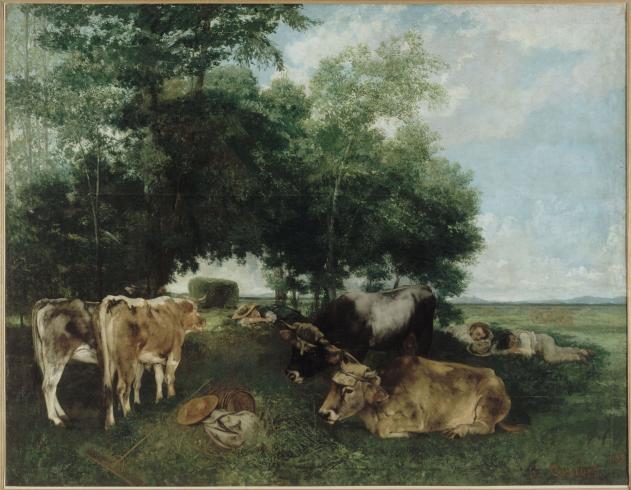This rural scene painted by Courbet offers a tranquil vision of peasant life, depicted in a monumental format. It is a record of his stay with his friend Doctor Ordinaire during the summer of 1867.
The composition is based on three sleeping figures. Exhausted by the work in the fields, the country farmers are taking a rest in the shade of the trees. The oxen have been released from their cart, which can be seen in the background. The two sons of Doctor Ordinaire, Olivier and Marcel, acted as models for the sleeping reapers. Initially, there was a girl in the front of the composition instead of the still life. Courbet altered his work after the Salon of 1869, preferring to replace this additional figure with still life.
Like Constant Troyon (1810-1865) and Rosa Bonheur (1822-1899) a few years earlier, Courbet often depicted peaceful rural scenes in large formats. The Siesta during the haying season is in this sense characteristic of the changes in genres which occurred at the Salon during the French Second Empire. The rise of genre painting and development of historical painting led to changes in the traditional categories. When Gustave Courbet exhibited this painting, which was more than two metres in height with bovines in the foreground, he was following in the footsteps of Troyon. During the World Exhibition of 1855, the latter exhibited his monumental work Oxen at work, (Musée d’Orsay). More than four metres tall, this painting elevated animal painting to the same status as historical painting. Courbet had already used such large dimensions when exhibiting Damsels on the banks of the Seine (Musée du Petit Palais) at the Salon of 1857, an open-air scene with a realistic portrayal of human figures.
Gustave Courbet, in the summer of 1867, had great hopes for his painting of Siesta during the haying season, intended for the Salon of 1869. However, the reception it received from the public was a profound disappointment. The critics were very harsh with the artist: his oxen were “hydrocephalic” according to Armand Silvestre, Louis Auvray suspected the painter of having “a pronounced taste for ugliness”, while Paul Casimir-Perier classed the painting as “one of those paintings you’d rather ignore”. Nevertheless, this type of Dutch-inspired rural scene, on the frontier of animal painting, found its place. Ploughing in the Nivernais (Musée d’Orsay) by Rosa Bonheur was already twenty years old in 1869. A new generation of animal painters began to specialise in the depiction of bovines, and four years after the death of Troyon, his pupil Emile Van Marcke (1827-1891) successfully resumed the compositions which had made his master’s reputation and was awarded a medal at the same Salon in 1869. Courbet, eight years before his death, had not succeeded in making his mark among the animal paintings at this Salon. The work did not find a buyer and remained in the painter’s studio before being purchased by the City of Paris on the occasion of the posthumous sale organised in 1881.
H. V. de S.

City of Paris municipal collection's website
The collections portal can be used to search the collections of Paris’s 14 municipal museums (approximately 336,000 works, including 43,000 belonging to the Petit Palais).
It is also possible to download around 12,000 images of the museum’s works free of charge.
Access the Museums of the City of Paris collections portal
Extern databases
Discover a selection of databases online presenting works from the Petit Palais or documents concerning the history of the museum.

